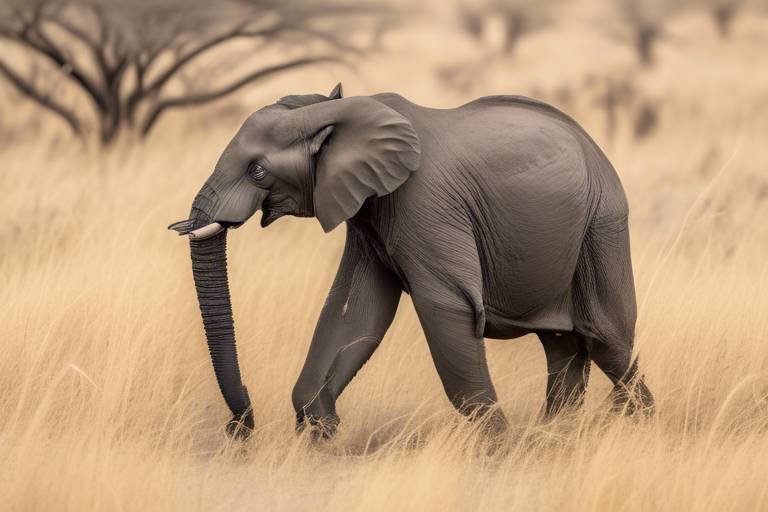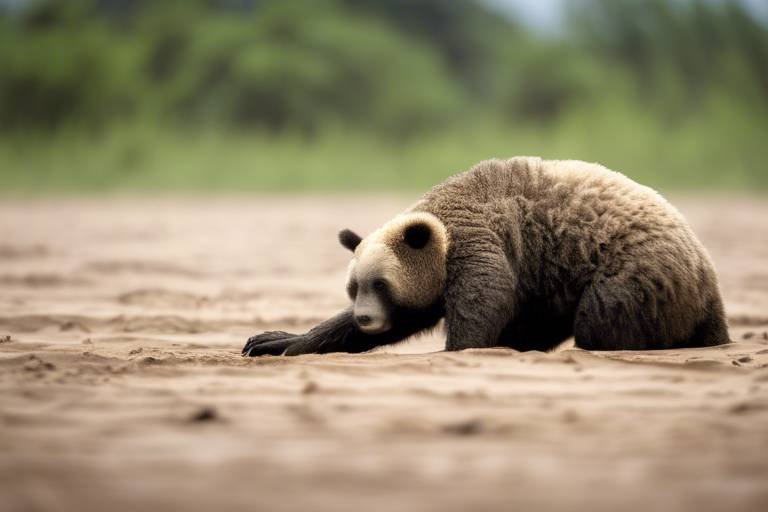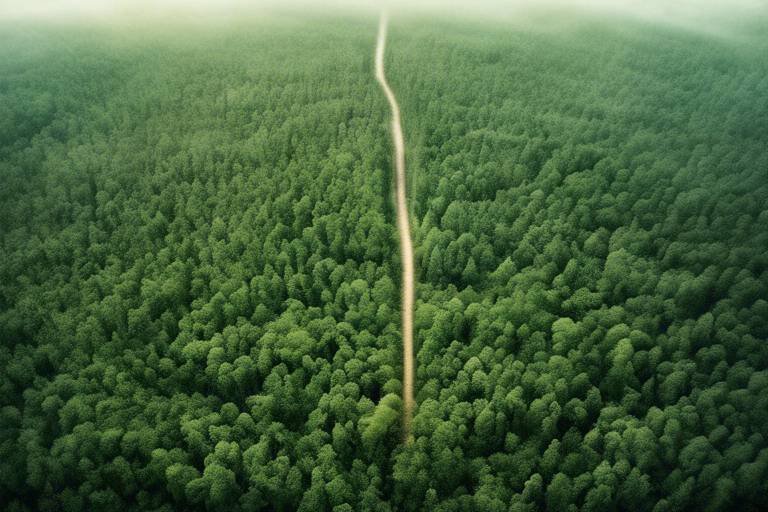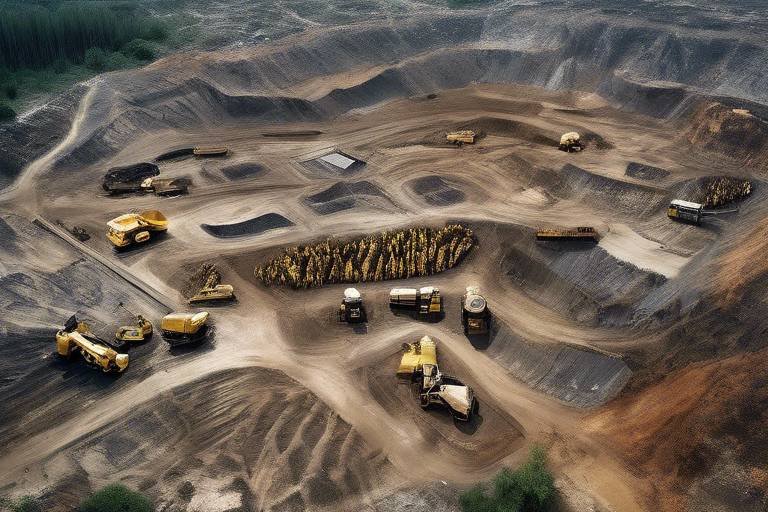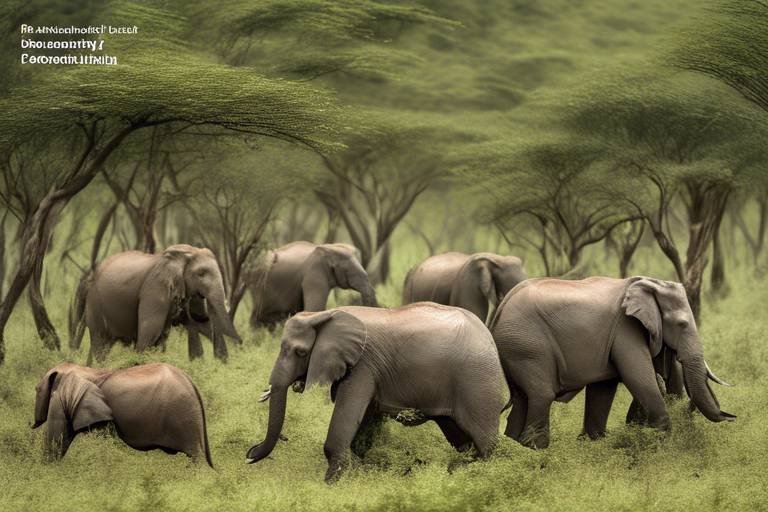Climate Change Refugees: The Plight of Polar Animals
As the world grapples with the urgent realities of climate change, one of the most heart-wrenching consequences is the plight of polar animals. These magnificent creatures, from the majestic polar bears to the playful seals, find themselves caught in a rapidly changing environment that threatens their very existence. Imagine living in a world where your home is melting away beneath your feet; that’s the reality for many species in the polar regions. In this article, we will explore the impact of climate change on these vulnerable populations, highlighting their struggles for survival, shifting migration patterns, and the broader implications for biodiversity and ecosystems.
The polar regions are witnessing some of the most dramatic effects of climate change, primarily through the melting of ice caps. This phenomenon is not just a statistic; it represents a significant loss of habitat for countless species. For polar bears, seals, and various seabirds, the ice serves as a crucial platform for hunting, breeding, and resting. As the ice diminishes, these animals are faced with a daunting challenge: adapt or perish. Polar bears, for instance, rely on sea ice to hunt seals, their main food source. With the ice melting earlier in the spring and forming later in the fall, these bears are forced to travel greater distances to find food, leading to increased energy expenditure and decreased health.
As climate change alters their environments, many polar animals are forced to migrate to new areas. This shift is not just a matter of moving from one place to another; it can have profound effects on their survival and the ecosystems they inhabit. For example, some species of fish are moving northward in search of cooler waters, which in turn affects the birds and mammals that rely on them as a food source. Polar animals are not just changing locations; they are altering their entire life cycles. The timing of migration, breeding, and feeding are all being disrupted, leading to mismatches in food availability and reproductive success.
Polar bears are often seen as the iconic symbols of the Arctic, embodying the beauty and fragility of this unique ecosystem. However, their survival is increasingly threatened by diminishing sea ice. These magnificent creatures rely heavily on ice for hunting seals and breeding. Without sufficient ice coverage, polar bears face a grim future. The harsh reality is that as the ice melts, these bears must venture farther and expend more energy to find food, which can lead to malnutrition or starvation.
With shrinking ice, polar bears face increased difficulty in hunting seals, their primary food source. Imagine trying to catch your dinner while standing on a rapidly melting ice floe; it’s a daunting task. As a result, many bears are experiencing significant declines in body condition, which directly affects their health and survival rates. The struggle for food is not just a personal battle for these bears; it has ripple effects throughout the ecosystem, threatening the balance of predator and prey.
The changing environment affects not only adult polar bears but also the survival of cubs. The success of breeding is closely linked to the availability of stable ice platforms, which provide safe spaces for mothers to raise their young. As the climate continues to warm, the chances of cub mortality increase. Studies have shown that cubs born during periods of extreme ice loss have lower survival rates, leading to concerns about the future population of polar bears. This cycle of hardship highlights the urgent need for conservation efforts to address these challenges.
Polar animals are not alone in their plight; marine life is also affected by climate change. As the ice melts, it alters the entire food chain in the polar regions. Warming waters can lead to shifts in fish populations, affecting the species that depend on them for food. Furthermore, the loss of ice impacts the breeding grounds for various marine species, leading to decreased populations and biodiversity. This interconnectedness of life in the polar regions emphasizes the need for a comprehensive understanding of how climate change affects all inhabitants of these fragile ecosystems.
Various organizations are working tirelessly to protect polar animals and their habitats from the effects of climate change. Conservation strategies range from habitat protection to community engagement and policy advocacy. For instance, initiatives aimed at reducing greenhouse gas emissions are crucial in slowing the pace of climate change and its impacts on polar regions. The effectiveness of these strategies can vary, but every effort counts in the fight to save these incredible animals.
Local communities play a crucial role in conservation efforts. Indigenous knowledge and practices contribute significantly to the protection of polar ecosystems. By understanding traditional methods of wildlife management and respecting the land, these communities can offer invaluable insights into sustainable practices that benefit both people and wildlife. Their involvement ensures that conservation measures are culturally appropriate and effective in the long term.
National and international policies are essential for addressing climate change impacts on polar animals. Existing legislation, such as the Marine Mammal Protection Act and the Endangered Species Act, provides a framework for conservation efforts. However, there is a pressing need for stronger protections to ensure the survival of polar species. Policymakers must prioritize climate action and habitat conservation to create a sustainable future for these iconic animals.
- What are climate change refugees? Climate change refugees are species that are forced to relocate due to the impacts of climate change on their habitats.
- How does climate change affect polar bears? Climate change leads to melting ice, which affects polar bears' ability to hunt and breed, threatening their survival.
- What can be done to help polar animals? Conservation efforts, community involvement, and strong policy measures are essential in protecting polar animals from climate change.

The Effects of Melting Ice Caps
As the Earth warms, the melting ice caps are becoming one of the most alarming indicators of climate change. For polar animals, these ice caps are not just beautiful landscapes; they are vital habitats that support their very existence. Imagine living in a world where your home is literally melting away—this is the harsh reality for species like polar bears and seals. The loss of ice affects their hunting grounds, breeding areas, and overall survival.
To understand the implications of melting ice caps, we need to consider the various ways in which these changes impact polar ecosystems:
- Habitat Loss: Polar bears rely on sea ice to hunt seals, their primary food source. As the ice diminishes, these bears are forced to swim longer distances to find food, which can lead to exhaustion and decreased survival rates.
- Breeding Challenges: Ice is essential for polar bear mothers to create dens where they give birth to their cubs. Without stable ice, the chances of cubs surviving to adulthood decrease significantly.
- Altered Food Sources: Seals and other marine animals that depend on ice for breeding and resting are also affected. As their populations decline, polar bears face an even steeper challenge in finding food.
Furthermore, the melting ice caps are not just a local issue; they have global repercussions. The loss of ice contributes to rising sea levels, which can lead to flooding in coastal areas around the world. This creates a ripple effect that impacts human communities, ecosystems, and wildlife alike. For example, as the ice melts, it releases methane, a potent greenhouse gas that exacerbates climate change, creating a vicious cycle that further threatens polar habitats.
In addition to the direct impacts on polar animals, the melting ice caps disrupt the entire ecosystem. Changes in temperature and salinity affect fish populations, which are crucial for the survival of many marine mammals. As these species struggle to adapt, the intricate balance of the Arctic food web is thrown into disarray. The consequences of this disruption are profound, not only for polar animals but also for the broader biodiversity that relies on these ecosystems.
In summary, the effects of melting ice caps are far-reaching and devastating. Polar animals are facing an uphill battle for survival as their habitats shrink and their food sources dwindle. The urgency of this crisis cannot be overstated; if we do not take action now, we risk losing not only these magnificent creatures but also the delicate balance of the ecosystems they inhabit.

Migration Patterns of Polar Species
The impact of climate change on polar regions is not just a story of melting ice and rising temperatures; it’s a tale of survival and adaptation. As the climate shifts, polar animals are finding themselves in a race against time, forced to change their migration patterns to find food, shelter, and breeding grounds. This shift is not just a minor inconvenience; it’s a profound alteration of their way of life that can have devastating effects on entire ecosystems.
One of the most striking examples of these changes can be seen in the migration patterns of species like the arctic terns and caribou. Traditionally, these animals followed well-established routes that allowed them to thrive in their habitats. However, as temperatures rise and ice melts, these routes are becoming less predictable. The terns, for instance, migrate from the Arctic to the Antarctic, but with changing weather patterns, they are now facing challenges in finding suitable breeding grounds.
In addition to birds, terrestrial animals such as caribou are also experiencing shifts. Their migration is closely tied to the availability of food sources, which are now being disrupted by the changing climate. During the summer months, caribou typically migrate to areas with lush vegetation. However, as the ground thaws earlier in the year, the plants they rely on may not be ready for grazing, leading to nutritional stress. This change can result in lower birth rates and higher mortality among calves, which is concerning for the future of the species.
Moreover, the polar bear, an iconic symbol of the Arctic, is also affected by these shifting patterns. As sea ice diminishes, polar bears are forced to swim greater distances to find stable ice to hunt seals. This increased effort can lead to exhaustion and lower survival rates, particularly for younger bears who are still learning to navigate their harsh environment. The table below summarizes the challenges faced by polar species due to altered migration patterns:
| Species | Traditional Migration Patterns | Current Challenges |
|---|---|---|
| Arctic Tern | Arctic to Antarctic | Unpredictable breeding grounds due to climate shifts |
| Caribou | Seasonal grazing routes | Nutritional stress from disrupted food sources |
| Polar Bear | Hunting on stable sea ice | Increased swimming distances, leading to exhaustion |
As these animals adapt to new realities, the consequences ripple through their ecosystems. For instance, when polar bears struggle to find food, it affects not only their population but also the seals they hunt. Fewer seals mean less competition for food, but it also disrupts the balance of marine life. This interconnectedness highlights the fragility of polar ecosystems in the face of climate change.
In conclusion, the migration patterns of polar species are undergoing significant changes due to climate change. These shifts pose serious threats to their survival and the health of their ecosystems. Understanding these patterns is crucial for conservation efforts and for ensuring a future where these magnificent animals can continue to thrive in their natural habitats.
- What are climate change refugees? Climate change refugees are species that are forced to migrate due to changes in their environment caused by climate change.
- How does climate change affect polar animals? Climate change leads to habitat loss, altered migration patterns, and changes in food availability, impacting the survival of polar animals.
- What can be done to help polar species? Conservation efforts, community involvement, and stronger policies are essential to protect polar animals and their habitats from climate change.

Polar Bears: Kings of the Ice
Polar bears are often regarded as the majestic kings of the Arctic, embodying the spirit of the icy wilderness. These magnificent creatures have adapted to thrive in one of the harshest environments on the planet. However, their very existence is now under siege due to the relentless impacts of climate change. As the ice caps melt at an alarming rate, polar bears find themselves in a precarious situation that threatens their survival.
One of the most pressing challenges for polar bears is their dependence on sea ice for hunting seals, their primary food source. Imagine a skilled hunter whose hunting grounds are disappearing right beneath their feet; that’s the reality for these bears. The ice serves as a platform from which they can hunt, breed, and rest. With each passing year, the ice retreats further, forcing polar bears to swim longer distances in search of food, which not only exhausts them but also puts their cubs at risk.
The changing climate has led to a substantial decrease in the availability of sea ice during critical periods, particularly in the summer months. This seasonal shift means that polar bears are left with fewer opportunities to hunt, leading to significant health issues and decreased survival rates. The struggle for sustenance is real, and it’s not just about the bears; the entire ecosystem is affected. The food chain becomes disrupted as seals, too, are impacted by the warming waters and loss of habitat.
Moreover, the implications of climate change extend beyond just hunting. The breeding success of polar bears is also in jeopardy. The stress of finding food can lead to poor health, which in turn affects the reproductive capabilities of adult bears. Female polar bears require substantial fat reserves to successfully rear their cubs. The reduced ice coverage means that they have less time to build these reserves before giving birth, leading to increased cub mortality rates. It’s a heartbreaking cycle: fewer hunting opportunities lead to fewer healthy cubs, which threatens the future of the species.
In summary, polar bears are not just symbols of the Arctic; they are vital components of their ecosystem. Their struggle against the melting ice caps is a stark reminder of the broader consequences of climate change. As these magnificent creatures face increasing challenges, it becomes crucial for us to understand their plight and take action to protect their habitats. The survival of polar bears is not just about saving a species; it’s about preserving the intricate balance of the Arctic ecosystem, which affects us all.
- What are the main threats to polar bears? The primary threats include melting ice due to climate change, reduced hunting opportunities, and habitat loss.
- How does climate change affect polar bear cubs? Climate change leads to a decrease in food availability, which affects the health of mother bears and increases cub mortality rates.
- What can be done to help polar bears? Conservation efforts, policy changes, and community involvement are essential to protect polar habitats and promote sustainability.

Hunting Challenges
The majestic polar bear, often referred to as the "king of the ice," faces an uphill battle when it comes to hunting in our rapidly changing climate. With the ice caps melting at an alarming rate, these incredible creatures are finding it increasingly difficult to secure their primary food source: seals. Imagine trying to catch your favorite meal while the very platform you rely on for stability is crumbling beneath you. This is the harsh reality for polar bears today.
As the sea ice diminishes, polar bears are forced to venture further and expend more energy in their quest for food. This is not just a minor inconvenience; it has significant implications for their overall health and survival. In fact, studies have shown that bears are experiencing higher rates of malnutrition as they struggle to find enough seals to sustain themselves. Without sufficient fat reserves, these bears are left vulnerable to a host of health issues, including weakened immune systems and reduced reproductive success.
Moreover, the hunting landscape is changing. Polar bears typically hunt seals by waiting at breathing holes in the ice, but as these holes become less predictable due to shifting ice patterns, bears are left with fewer opportunities to catch their prey. The challenges are compounded when you consider that seals themselves are also adapting to these changes, moving to areas where ice is still present or finding new habitats altogether. This introduces a new layer of complexity to the polar bear's already challenging hunt.
To illustrate the impact of these challenges, consider the following table that summarizes the key factors affecting polar bear hunting success:
| Factor | Impact on Hunting |
|---|---|
| Melting Ice | Reduces stable hunting platforms, forcing bears to swim longer distances. |
| Seal Migration | Seals are moving to new areas, making them harder to find. |
| Energy Expenditure | Increased energy use leads to higher chances of malnutrition. |
| Climate Variability | Unpredictable weather patterns affect ice formation and seal behavior. |
As the Arctic continues to warm, the hunting challenges faced by polar bears are only expected to worsen. The implications of these changes extend beyond just the bears themselves; they ripple through the entire ecosystem. As apex predators, polar bears play a crucial role in maintaining the balance of their environment. When their hunting success declines, it can lead to overpopulation of seal species, which in turn affects other marine life. This interconnectedness highlights the urgency of addressing climate change and its far-reaching effects on polar ecosystems.
In conclusion, the hunting challenges faced by polar bears are a stark reminder of the broader issues stemming from climate change. As we witness these magnificent animals struggle for survival, it becomes increasingly clear that urgent action is needed to protect not only the polar bears but the fragile ecosystems they inhabit.

Breeding and Cub Survival
The survival of polar bear cubs is a critical concern in the face of climate change. As the ice melts and habitats shift, the challenges these majestic creatures face during breeding season become increasingly daunting. Polar bears typically give birth during the harsh winter months, when they seek refuge in dens dug into the snow. These dens are not just cozy homes; they are essential for the protection and survival of newborn cubs. However, as temperatures rise and snow becomes less reliable, the integrity of these dens is compromised.
When a mother polar bear, known as a sow, gives birth, she relies heavily on the insulating properties of the snow to keep her cubs warm. Unfortunately, with climate change causing unpredictable weather patterns, the snow cover may not be as thick or stable as it once was. This instability can lead to den collapse or exposure to extreme cold, which can be fatal for the vulnerable cubs. The survival rate of these cubs is intricately linked to the conditions of their environment. If the den fails to provide adequate protection, the likelihood of cub mortality increases significantly.
Moreover, the availability of food plays a pivotal role in cub survival. A mother bear needs to consume sufficient calories to nurse her cubs, which can weigh up to 1.5 pounds at birth but grow rapidly in their first few months. The primary source of nourishment for polar bears comes from seals, which they hunt on the sea ice. With the ice melting earlier each year, mothers are forced to venture farther to find food, often leaving their cubs behind in the den for longer periods than is ideal. This separation can lead to malnourishment and increased vulnerability to predators.
Research indicates that the cubs' survival rates are declining as a direct consequence of these environmental changes. Studies have shown that cubs born during years of significant ice loss have a 30% lower survival rate than those born in more stable conditions. This alarming trend not only threatens the future of polar bears but also disrupts the delicate balance of the Arctic ecosystem.
In summary, the breeding and survival of polar bear cubs are inextricably linked to the health of their environment. As climate change continues to alter their habitats, the challenges faced by these iconic animals grow more severe. It is imperative that we understand these dynamics and work towards solutions that can help safeguard their future.
- What are the main threats to polar bear cubs? The primary threats include habitat loss due to melting ice, food scarcity, and increased predation risks.
- How does climate change affect polar bear breeding? Climate change leads to unstable snow conditions for dens, and reduced sea ice limits hunting opportunities for mothers.
- What can be done to help polar bears? Conservation efforts, habitat protection, and reducing greenhouse gas emissions are crucial to help polar bears survive.

Impact on Marine Life
The impact of climate change on polar animals extends beyond the land and ice; it significantly affects marine life as well. As the planet warms, the delicate balance of marine ecosystems is disrupted, leading to a cascade of consequences that ripple through the food chain. For instance, the melting ice caps not only threaten the habitat of iconic species like polar bears but also alter the habitats of various marine organisms. Fish, seals, and other marine creatures are experiencing shifts in their populations and behaviors due to changing water temperatures and ice coverage.
One of the most pressing issues is the warming of ocean waters. As temperatures rise, the distribution of fish species is changing, forcing them to migrate to cooler waters. This not only affects the fish themselves but also the predators that rely on them for food, such as seals and polar bears. The food web becomes increasingly unstable, leading to potential declines in fish populations that are crucial for the survival of larger marine mammals.
Additionally, the melting ice impacts the breeding and feeding grounds of many marine species. Ice serves as a platform for seals to give birth and nurse their pups, and its absence can lead to increased mortality rates among young seals. This, in turn, affects the polar bears that depend on seals as their primary food source. The interconnectedness of these species highlights the urgency of understanding and addressing the impacts of climate change.
Furthermore, warmer waters can lead to the proliferation of harmful algal blooms, which can produce toxins that affect marine life and human health. These blooms can deplete oxygen in the water, creating "dead zones" where aquatic life cannot survive. As marine ecosystems struggle to adapt, the consequences are felt not just by polar animals but by all species that rely on these environments.
To illustrate the interconnectedness of these changes, consider the following table that highlights key marine species affected by climate change:
| Species | Impact of Climate Change |
|---|---|
| Arctic Cod | Shifting habitats due to warming waters, affecting food availability for seals and polar bears. |
| Walruses | Loss of sea ice for resting and breeding, leading to increased competition for food. |
| Seals | Reduced breeding success due to lack of ice platforms, impacting predator species like polar bears. |
In conclusion, the plight of polar animals is intricately linked to the health of marine ecosystems. As climate change continues to threaten these environments, the survival of numerous species hangs in the balance. Addressing the challenges posed by climate change is not just about saving polar bears or seals; it’s about preserving the entire marine ecosystem that supports a rich tapestry of life.
- What is causing climate change? Climate change is primarily caused by human activities, particularly the burning of fossil fuels, deforestation, and industrial processes that increase greenhouse gas emissions.
- How does climate change affect polar bears? Climate change leads to melting ice caps, which diminishes the polar bears' hunting grounds, making it difficult for them to find food and breed.
- What are the consequences of melting ice on marine life? Melting ice alters habitats, affects breeding grounds, and can lead to shifts in species distribution, which disrupts the entire food chain.
- What can be done to help polar animals? Conservation efforts, including habitat protection, sustainable practices, and policy changes, are essential to mitigate the impacts of climate change on polar animals and their ecosystems.

Conservation Efforts
In the face of escalating climate change, have become more critical than ever for the survival of polar animals. Organizations around the globe are stepping up to the plate, devising strategies to protect these vulnerable species and their habitats. The urgency of the situation cannot be overstated. With the ice caps melting at an alarming rate, every action counts, and the fight to preserve these ecosystems is a race against time.
One of the most significant initiatives involves the establishment of protected areas. These designated zones serve as safe havens for polar animals, allowing them to thrive in environments less affected by human activity. For instance, the creation of marine protected areas (MPAs) has been instrumental in safeguarding crucial habitats for seals and other marine life. By restricting fishing and other disruptive activities, these zones help maintain the delicate balance of the ecosystem. However, the effectiveness of these measures largely depends on the enforcement of regulations and the cooperation of local communities.
Speaking of local communities, their involvement is paramount in the conservation narrative. Indigenous knowledge and practices provide invaluable insights into sustainable living and resource management. Community-led conservation initiatives have shown promising results, as local populations often have a deep understanding of their environment. For example, in some regions, indigenous groups are collaborating with scientists to monitor wildlife populations and track changes in the ecosystem. This partnership not only empowers local communities but also enhances the effectiveness of conservation strategies.
Furthermore, policy and legislation play a crucial role in shaping conservation efforts. National and international frameworks are essential for addressing the broader impacts of climate change on polar ecosystems. Agreements such as the Paris Agreement aim to limit global warming and its effects on biodiversity. However, the implementation of these policies often faces challenges, including political resistance and lack of funding. To truly make a difference, stronger protections and more robust enforcement mechanisms are needed.
| Conservation Strategies | Description | Effectiveness |
|---|---|---|
| Protected Areas | Designated zones that limit human activity to protect wildlife habitats. | High, if enforced properly |
| Community Involvement | Engaging local populations in conservation efforts using indigenous knowledge. | Moderate to High, depending on collaboration |
| Policy and Legislation | National and international laws aimed at reducing climate change impacts. | Variable, often requires stronger enforcement |
In addition to these strategies, raising awareness about the plight of polar animals is essential. Education campaigns can mobilize public support and encourage individuals to participate in conservation efforts. When people understand the stakes involved, they are more likely to advocate for policies that protect these magnificent creatures. Social media campaigns, documentaries, and community workshops are just a few ways to spread the word and inspire action.
Ultimately, the fight for polar animals is a collective responsibility. While organizations, communities, and governments play pivotal roles, every individual can contribute to the cause. Whether it's reducing carbon footprints, supporting sustainable practices, or simply spreading awareness, every effort counts in this critical battle against climate change.
- What are climate change refugees? Climate change refugees are species that are forced to migrate due to changes in their habitat caused by climate change.
- How does climate change affect polar bears? Polar bears rely on sea ice for hunting seals, their primary food source. As ice melts, their ability to hunt and breed is severely impacted.
- What can individuals do to help? Individuals can reduce their carbon footprint, support conservation organizations, and educate others about the importance of protecting polar ecosystems.
- Are there successful conservation projects? Yes, many projects have shown success, particularly those that involve local communities and establish protected areas.

Community Involvement
When it comes to tackling the challenges posed by climate change, the role of local communities is absolutely crucial. These communities, particularly indigenous populations, possess a wealth of traditional knowledge that has been passed down through generations. This knowledge is not just useful; it is vital for the conservation of polar ecosystems. Think of these communities as the guardians of the Arctic, holding keys to sustainable practices that can help mitigate the impacts of climate change.
Indigenous peoples have lived in harmony with the land for centuries, and their understanding of the local environment is unparalleled. They know the behaviors of polar animals, the seasonal changes in ice, and the delicate balance of their ecosystems. By integrating this traditional knowledge with modern conservation strategies, we can create a more effective approach to protecting polar habitats. For instance, local hunters often observe changes in animal migration patterns and can provide invaluable insights to scientists.
Moreover, community involvement goes beyond just traditional knowledge. It fosters a sense of ownership and responsibility towards the environment. When local communities are engaged in conservation efforts, they are more likely to take action to protect their habitats. This can involve:
- Participating in wildlife monitoring programs
- Engaging in sustainable hunting practices
- Advocating for environmental policies at local and national levels
One striking example of community involvement is the collaborative initiatives between local groups and environmental organizations. These partnerships often lead to innovative solutions tailored to the unique challenges faced by polar animals. For instance, some communities have adopted eco-tourism as a way to generate income while promoting conservation. By attracting visitors interested in seeing polar wildlife, they help raise awareness about the plight of these animals and the importance of preserving their habitats.
However, it’s not just about local communities taking action; it’s also about the support they receive from governments and international organizations. Policies that recognize and empower indigenous rights are essential. When communities are given a voice in decision-making processes, they can advocate for their needs and protect their land more effectively.
In conclusion, the involvement of local communities in conservation efforts is not just beneficial; it is necessary for the survival of polar animals. By combining traditional knowledge with modern science, fostering community ownership, and advocating for supportive policies, we can create a holistic approach to combat the effects of climate change. The survival of polar ecosystems may very well depend on the collaboration between these communities and conservationists worldwide.
1. Why is community involvement important in conservation efforts?
Community involvement is crucial as it brings traditional knowledge to the forefront, fosters a sense of ownership, and encourages sustainable practices that benefit both the environment and local populations.
2. How can indigenous knowledge contribute to conservation?
Indigenous knowledge provides insights into local wildlife behaviors and ecosystem dynamics, which can help scientists and conservationists develop more effective strategies for protecting polar habitats.
3. What role do local communities play in eco-tourism?
Local communities can develop eco-tourism initiatives that promote awareness of polar ecosystems while providing economic benefits, thus incentivizing conservation efforts.

Policy and Legislation
Addressing the impacts of climate change on polar animals requires robust . National and international frameworks play a pivotal role in shaping the conservation efforts that protect these vulnerable species. As the world becomes increasingly aware of the consequences of climate change, it is essential to highlight the existing policies that aim to mitigate its effects and explore the gaps that still need to be filled.
At the international level, agreements such as the Paris Agreement seek to limit global warming, which directly impacts polar regions. By committing to reducing greenhouse gas emissions, countries can help slow down the melting of ice caps and preserve the habitats of polar animals. However, the effectiveness of such agreements largely depends on the commitment of individual nations to implement and adhere to their provisions. This raises the question: are countries doing enough?
In addition to international agreements, national legislation is crucial for the protection of polar ecosystems. Many countries with polar territories have enacted laws aimed at safeguarding wildlife and preserving their habitats. For instance, the Marine Mammal Protection Act in the United States provides a framework for the conservation of marine mammals, including seals and polar bears. Yet, enforcement remains a significant challenge due to limited resources and political will.
Furthermore, local laws often intersect with indigenous rights and practices. Indigenous communities possess invaluable knowledge about their environments, and their involvement in conservation efforts is essential. Legislation that recognizes and incorporates indigenous rights can lead to more effective management of polar ecosystems. For example, co-management agreements between governments and indigenous groups can ensure that conservation strategies are culturally appropriate and scientifically sound.
Despite these efforts, there is a pressing need for stronger protections. Many existing policies are fragmented and lack the necessary funding for implementation. A comprehensive approach that includes:
- Increased funding for research and conservation initiatives
- Stricter regulations on carbon emissions
- Enhanced cooperation between nations
is essential to ensure the survival of polar animals. Additionally, public awareness campaigns can mobilize support for stronger legislation and encourage individuals to advocate for policy changes.
To summarize, effective policy and legislation are critical in the fight against climate change and its impact on polar animals. By strengthening existing frameworks and fostering collaboration between governments, indigenous communities, and conservation organizations, we can create a more sustainable future for these magnificent creatures. The question remains: will we act in time to protect them?
- What are climate change refugees?
Climate change refugees are species that are forced to migrate or adapt due to changes in their environment caused by climate change. - How does climate change affect polar bears?
Climate change leads to the melting of sea ice, which polar bears rely on for hunting seals and breeding. - What can individuals do to help polar animals?
Individuals can support conservation organizations, reduce their carbon footprint, and advocate for stronger environmental policies. - Are there any successful conservation efforts for polar animals?
Yes, various organizations are making strides in protecting polar habitats, but ongoing support and stronger legislation are needed.
Frequently Asked Questions
- What are climate change refugees?
Climate change refugees are species, including polar animals, that are forced to relocate due to the drastic changes in their habitats caused by climate change. As ice caps melt and temperatures rise, these animals must find new areas to survive, often leading to increased competition and stress on their populations.
- How does melting ice affect polar bears?
Melting ice caps significantly impact polar bears by reducing their hunting grounds. These majestic creatures rely on sea ice to hunt seals, their primary food source. With less ice available, polar bears face greater challenges in finding food, which can lead to malnutrition and lower survival rates.
- What changes are occurring in the migration patterns of polar species?
As climate change alters their environments, many polar species are being forced to migrate to new areas in search of suitable habitats. This shift can disrupt existing ecosystems, as these animals may compete with local species for resources, leading to unforeseen ecological consequences.
- How does climate change impact the breeding success of polar bears?
The changing environment affects not only adult polar bears but also their cubs. With diminishing ice, breeding success can decline as mothers struggle to find enough food to nourish themselves and their young. This can lead to higher cub mortality rates and threaten the future of polar bear populations.
- What is the impact of climate change on marine life in polar regions?
Warming waters and melting ice have a ripple effect on marine life, disrupting the entire food chain. Species that rely on cold water temperatures may decline, while others that thrive in warmer conditions may move in, altering the balance of the ecosystem and affecting the animals that depend on them for survival.
- What conservation efforts are in place to protect polar animals?
Various organizations are actively working to protect polar animals and their habitats through conservation strategies. These efforts include habitat restoration, policy advocacy, and community engagement to ensure that both local ecosystems and the species that inhabit them are safeguarded against the impacts of climate change.
- How can local communities contribute to conservation efforts?
Local communities, especially indigenous peoples, play a crucial role in conservation by utilizing their traditional knowledge and practices. By incorporating cultural insights and sustainable practices, they can help protect polar ecosystems and ensure the survival of the species that inhabit them.
- What policies are needed to protect polar animals from climate change?
To effectively address the impacts of climate change on polar animals, stronger national and international policies are essential. This includes legislation that prioritizes habitat protection, emissions reduction, and climate adaptation strategies to ensure the long-term survival of these vulnerable species.


